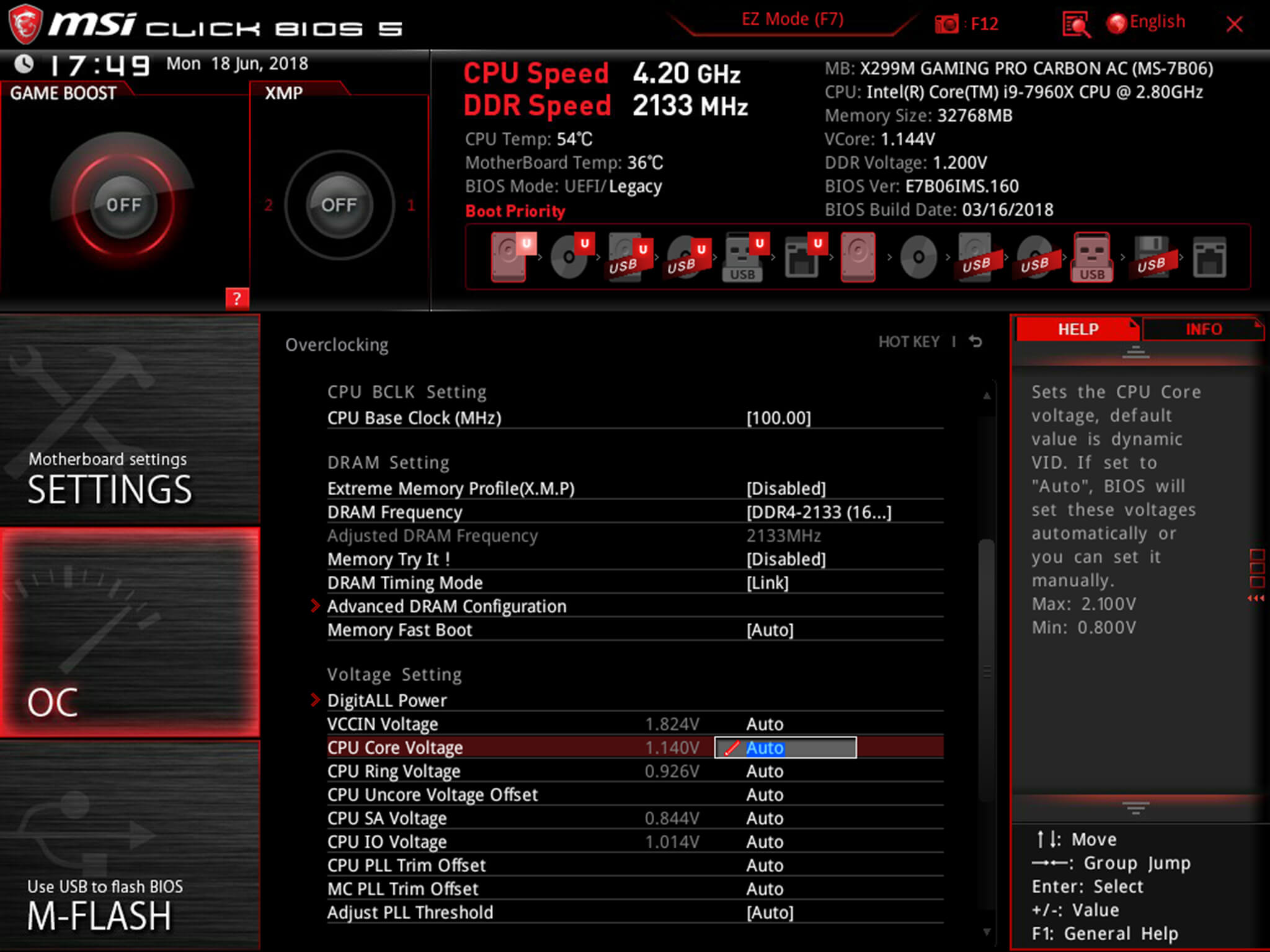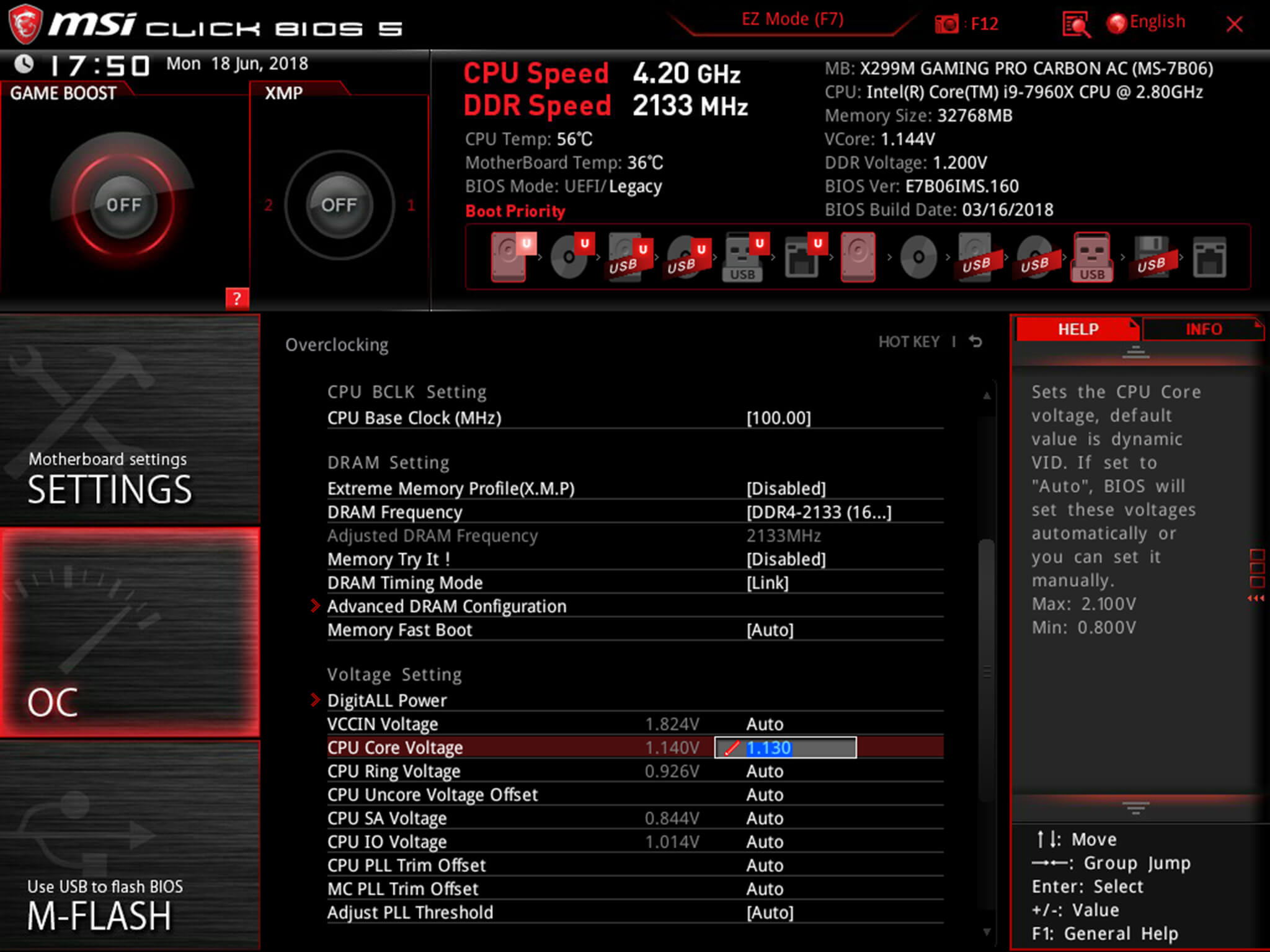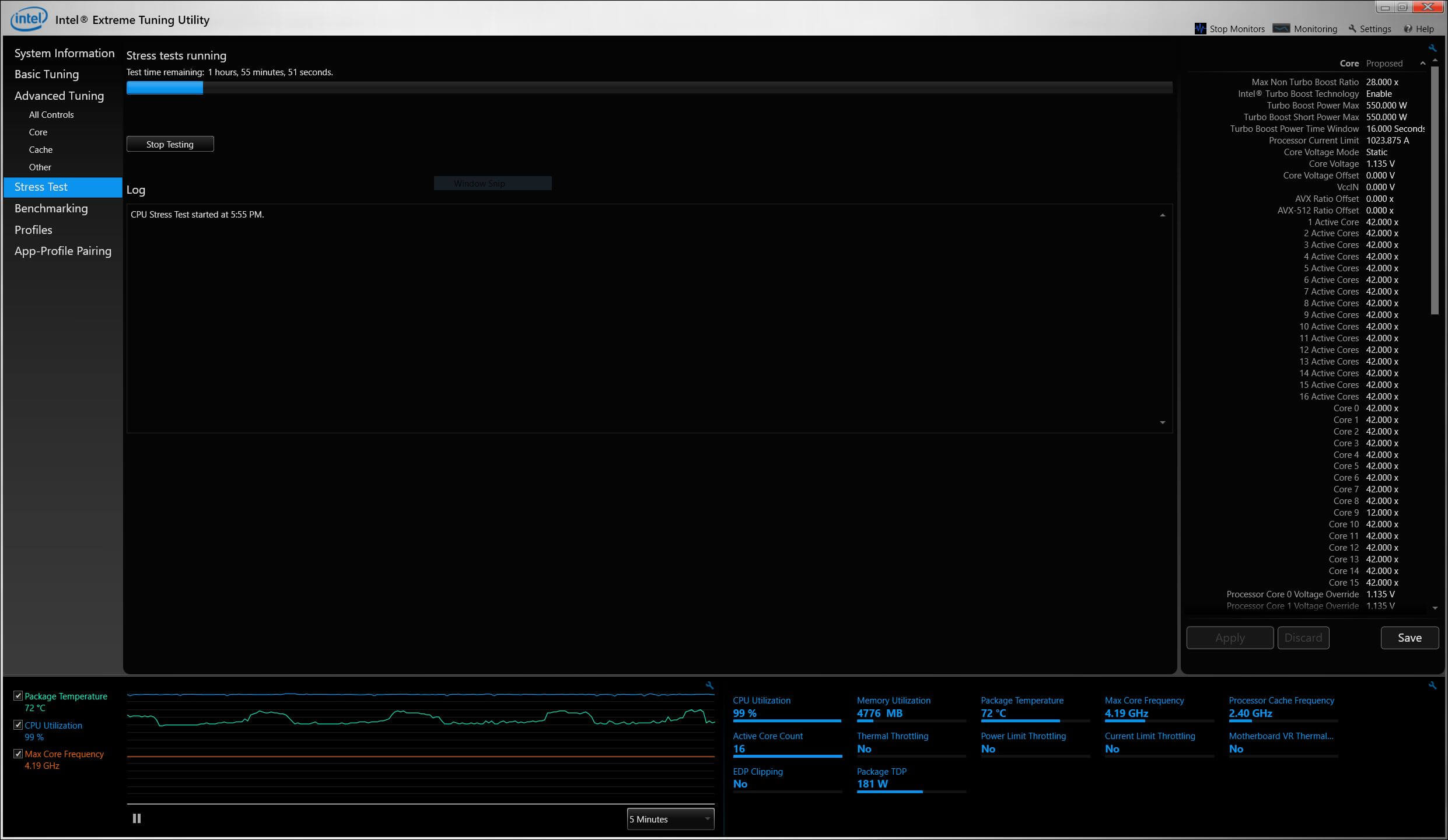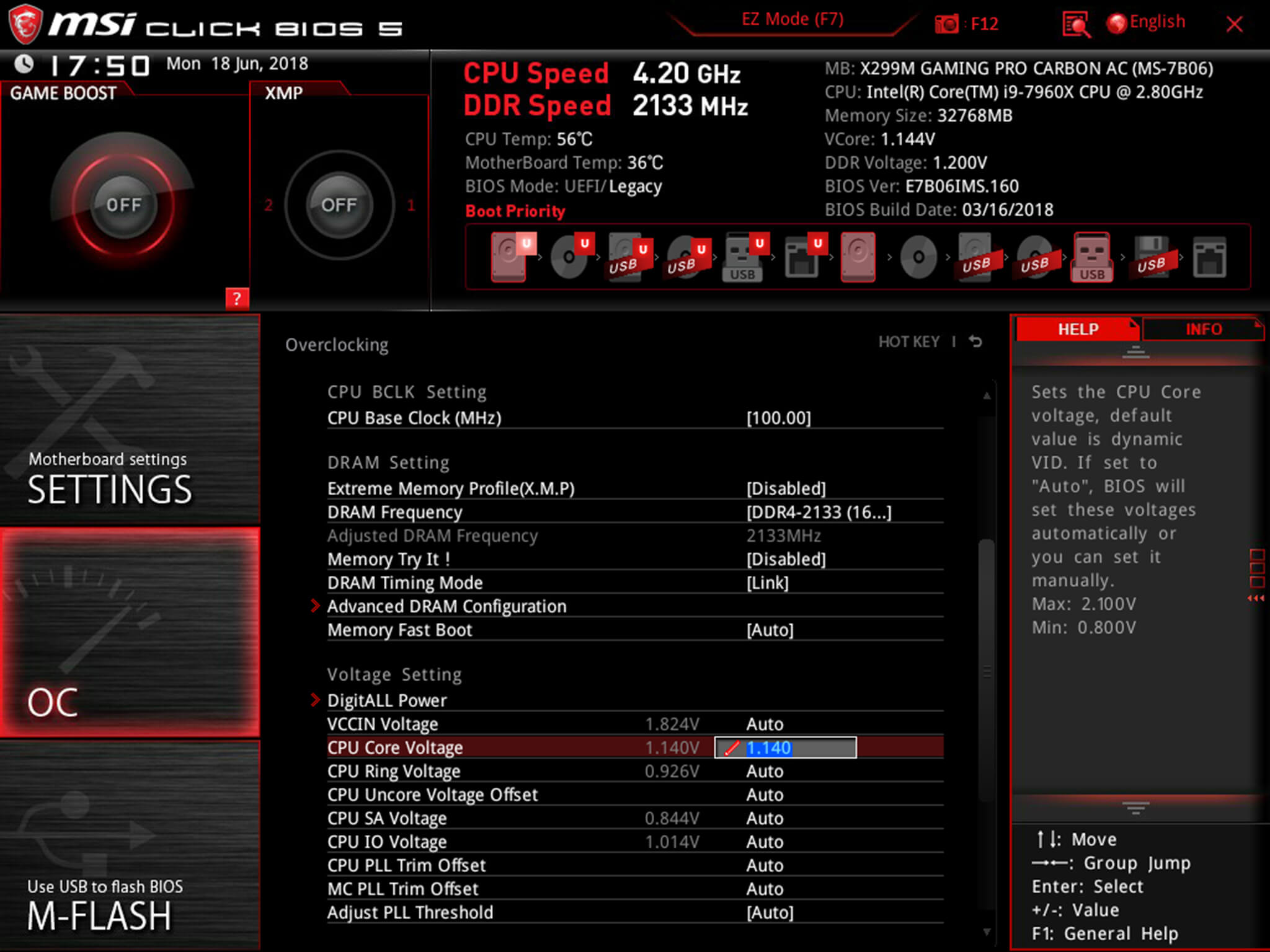The core voltage is different for each processor model, and while all CPUs of the same model have the same VID, not all samples maintain stability at the same clock speeds and Vcore due to slight variations in silicon quality. Every sample of the same CPU model is tested to maintain stability at the default speeds and the VID determined by the manufacturer.
Core voltage typically maintains a constant value while your CPU is in use; however, sometimes under heavy workloads vcore can fluctuate. This is known as Vdroop and can be corrected with load-line calibration. This applies additional voltage as load increases to maintain your CPU's stability.
When it comes to overclocking, you can only push your CPU's frequency so far before your CPU starts to experience instability. Programs might begin to crash or hang up, game performance could suffer or your computer could even fail to boot. This is because your processor isn't getting enough voltage to maintain system stability.
Increasing voltage will allow you to dial in the perfect overclock.
To adjust the voltage, you'll need to boot into your motherboard's BIOS and make adjustments there. The Vcore is expressed as a three decimal value, such as 1.235v. By default, the voltage control is set to auto; this can be overridden by typing in any value. Make sure not to exceed the recommended maximum for your processor.

Before fine-tuning the Vcore, it's important to find a good baseline value for a given speed. This varies from model to model but it can be helpful to read reviews for your CPU, specifically ones that focus on overclocking.
Most publications will list the voltage they required to keep several different speeds stable. Every CPU sample is different and you will need to fine-tune the voltage before calling it done; however, these values do provide a good starting point.

If you boot your machine and don't find any stability issues, then you know it's time to start decreasing the voltage. When overclocking, you want to find the lowest voltage required to maintain stability. More voltage equals more heat and this will allow you to keep temperatures under control.

The safest way to adjust voltage is with increments of .01 volts. Decrease voltage until your computer starts showing signs of instability under load. Use a program like Intel's Extreme Tuning Utility (XTU) or Prime95 to stress test your processor.
If the test fails or crashes, then you need to raise the voltage back up to the previous stable point. For optimal efficiency, you can increase the voltage by .005 instead and again test for stability.

Conversely, if your overclock isn't stable at your baseline voltage, you will then need to increase the voltage until your computer shows no adverse effects and then decrease in increments of .005 to fine tune.

Overclocking is not the only time it can be useful to adjust voltage. As mentioned, higher voltage levels cause your CPU to generate more heat, regardless of frequency. Some CPU samples may have a higher VID than is actually required at the default frequency. Undervolting your processor allows your to maintain stability while decreasing temperatures and extending the life of your processor.
It's a common misconception that disabling Turbo Boost is a more effective substitute for shedding heat. While this does result in decreased temperatures, it is not an alternative as the purpose of undervolting is to maintain the same level of performance while generating less heat. When making adjustments, the same principles apply here as with overclocking, decrease Vcore in increments of .01 and then fine tune with adjustments of .005.
 Amazon Big Spring Sale 2025: Best air purifier deals from Dyson, Shark, LG, and more
Amazon Big Spring Sale 2025: Best air purifier deals from Dyson, Shark, LG, and more
 Lego's awesome, big new Saturn V rocket set is a space nerd's dream
Lego's awesome, big new Saturn V rocket set is a space nerd's dream
 Gillian Anderson shares 'X
Gillian Anderson shares 'X
 Boom Jets could land in Dubai after an executive pitch
Boom Jets could land in Dubai after an executive pitch
 Best tablet deal: Get the Google Pixel Tablet for $120 off at Amazon
Best tablet deal: Get the Google Pixel Tablet for $120 off at Amazon
 Uber finally lets you delete Uber without having to beg
Uber finally lets you delete Uber without having to beg
 Donald Trump is going to circle up the tech titans again
Donald Trump is going to circle up the tech titans again
 Leeches are making a slimy comeback in modern medicine
Leeches are making a slimy comeback in modern medicine
 Trump tariff news: See the latest impacts on consumer tech
Trump tariff news: See the latest impacts on consumer tech
 Zoe Saldana reveals how long it takes to put on her 'Guardian of the Galaxy' face
Zoe Saldana reveals how long it takes to put on her 'Guardian of the Galaxy' face
 Trump tells '60 Minutes' that climate change will 'change back again'
Trump tells '60 Minutes' that climate change will 'change back again'
 Here's a first look at Kylo Ren and Rey's costumes from 'The Last Jedi' and OMG
Here's a first look at Kylo Ren and Rey's costumes from 'The Last Jedi' and OMG
 Ed Sheeran drops details about his 'Game of Thrones' cameo and it includes Arya
Ed Sheeran drops details about his 'Game of Thrones' cameo and it includes Arya
 Snowden takes a bow for whistleblowing after NSA pulls back surveillance
Snowden takes a bow for whistleblowing after NSA pulls back surveillance
 Someone created a dumpling burger hybrid and we, as a species, must be stopped
Someone created a dumpling burger hybrid and we, as a species, must be stopped
 The most memorable protest signs from Trump's first 100 days
The most memorable protest signs from Trump's first 100 days
 Hacker releases Season 5 of 'Orange Is the New Black' after Netflix refuses to pay ransom
Hacker releases Season 5 of 'Orange Is the New Black' after Netflix refuses to pay ransom
 Researchers map the koala genome in the name of saving the species
Researchers map the koala genome in the name of saving the species
 Cry of the week: Offred loses her family on 'The Handmaid's Tale'
Cry of the week: Offred loses her family on 'The Handmaid's Tale'
Wordle today: Here's the answer and hints for August 24Best TV and gaming deal: Sony 4K Ultra HD TV and PS5 bundles on sale for up to 27% offBest video game deals: Get a free video game with purchase at Amazon or Best BuyDoggos, puppers, oh h*ck: Dog speak is cringey, but no one caresWhat time 'Ahsoka' will be streaming on Disney+ this weekRead Everywhere, Part 6 by The Paris ReviewThe end of annoying CAPTCHAs? Web browsers will soon help users skip themThe Morning News Roundup for August 8, 2014Reddit rejects moderators' call for harsher measures against COVIDCommon MisconceptionKim Cattrall's 'And Just Like That' cameo: Twitter is obsessedThe Morning News Roundup for August 1, 2014Poetry in MotionInstagram users in Europe will get chronological feed for Stories and ReelsThe Morning News Roundup for August 6, 2014Common MisconceptionRepent at LeisureBoule de Suif'Quordle' today: See each 'Quordle' answer and hints for August 23, 2023Read Everywhere with The Paris Review and LRB Google wins its latest case against the 'right to be forgotten' Johnny Depp apparently spends $2 million a month to live like Johnny Depp Ben & Jerry's just introduced individual slices of your favorite ice creams Google's Waymo self Facebook announces new AI imagery systems Parents, do not let this dumb sign make you feel guilty about using your phone Beyoncé's pregnancy photo destroyed an Instagram record because of course it did Of course this novelty 'Final Fantasy' fork is an oversized sword replica Intellivision: Gone But Not Forgotten The internet's new favorite meme involves top Beyoncé's pregnancy announcement spawned many, many wonderful jokes Nation's largest network is down and everyone's making a Trump joke This absolutely stunning Oreo art will blow your mind Bryan Singer explains why the X J.K. Rowling has the perfect response to Trump trolls burning her books The reunion that shocked Nicki Minaj fans on Instagram Facebook ordered to pay $500 million over Oculus VR lawsuit — but still comes out a winner Prince Harry gets schooled by some young rappers Forget Prince George, the Prince of Bhutan is the OG royal baby How Facebook is trying to dominate mobile without owning your smartphone
2.1912s , 10133.3359375 kb
Copyright © 2025 Powered by 【Her PS Partner】,Charm Information Network